FRIDAY, JUNE 17
■ The waning gibbous Moon rises around midnight tonight with Saturn glowing to its left (by about 7°). Saturn is magnitude +0.7. Partway between it and the Moon look for Delta Capricorni, magnitude +2.8.
By the beginning of dawn Saturday morning the 18th, this array is high in the south — now aligned more upright, as shown below.
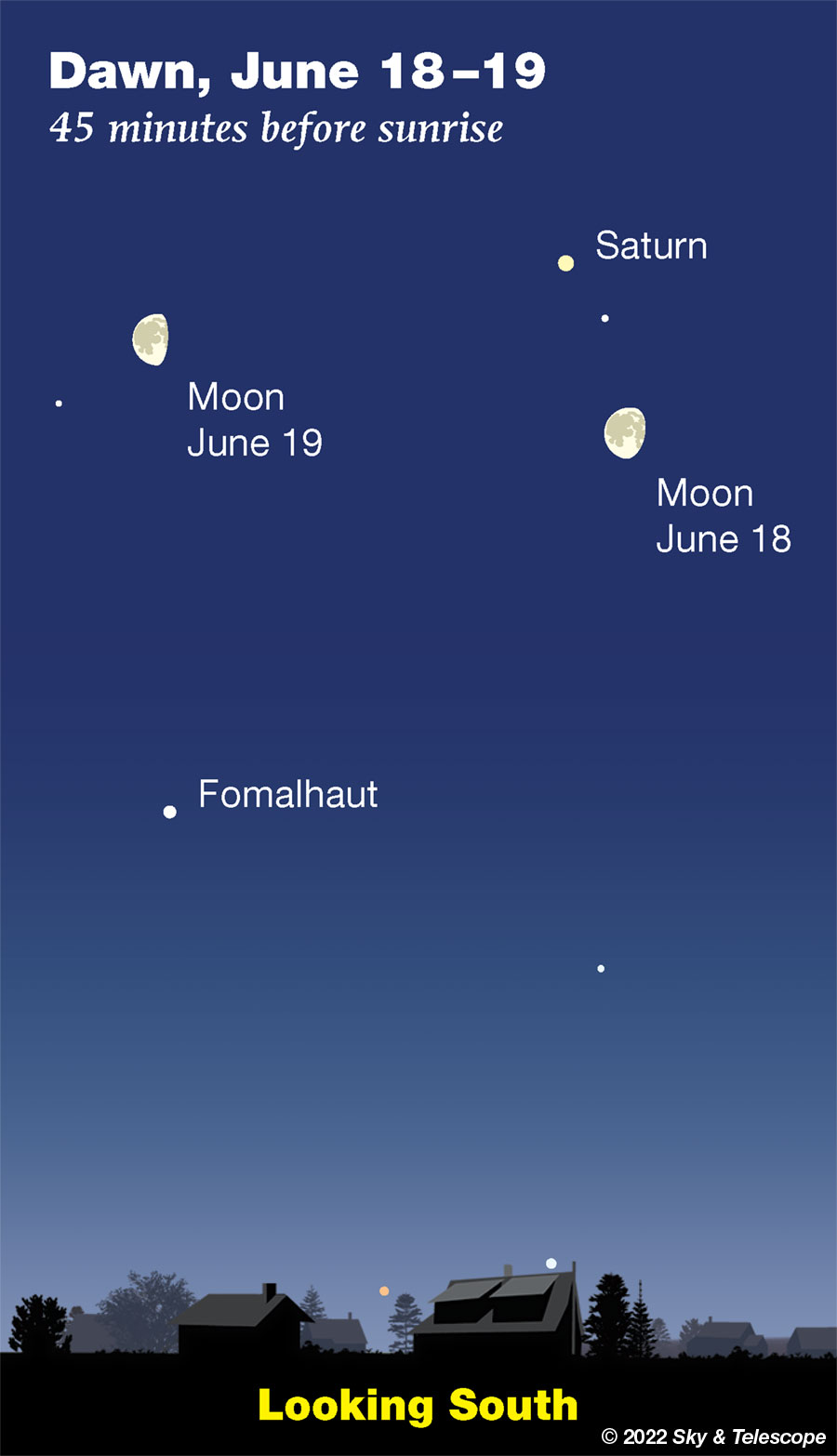
SATURDAY, JUNE 18
■ The Big Dipper hangs down by its handle high in the northwest. Spot the star at the end of its handle, the highest one. That's Alkaid, the tail of Ursa Major.
Now spot the Sickle of Leo much lower and in the west. The brightest star about two fists upper left of the Sickle is Denebola, the tail of a different carnivore: Leo.
About one third of the way from Alkaid to Denebola is a fainter star: Cor Caroli (Alpha Canum Venaticorum), a lovely telescopic double.
And what is two thirds of the way down that line? Nothing? Look again, maybe in a darker sky or with wide-field binoculars. You're looking into the big, dim Coma Berenices star cluster.
The cluster's brightest members form a sort of upside-down Y. The entire cluster is about 4° wide — a big, dim, irregular glow in a fairly dark sky, roughly the size of a ping-pong ball at arm's length. It nearly fills a binocular view.
SUNDAY, JUNE 19
■ The central stars of the little constellation Lyra, forming a small triangle and parallelogram, dangle lower right from bright Vega high in the east. The two brightest stars of the pattern, after Vega, are the two forming the bottom of the parallelogram: Beta and Gamma Lyrae, Sheliak and Sulafat. They're currently lined up vertically. Beta is the one on top.
Beta Lyrae is an eclipsing binary star. Compare it to Gamma whenever you look up at Lyra. Normally Beta is only a tiny trace dimmer than Gamma. Eventually, however, you'll catch Beta when it is quite obviously dimmer than usual.
MONDAY, JUNE 20
■ The last-quarter Moon rises around 1 or 2 a.m. tonight, with Jupiter to its left or upper left. By dawn on Tuesday the 21st they stand high in the southeast, as shown below.
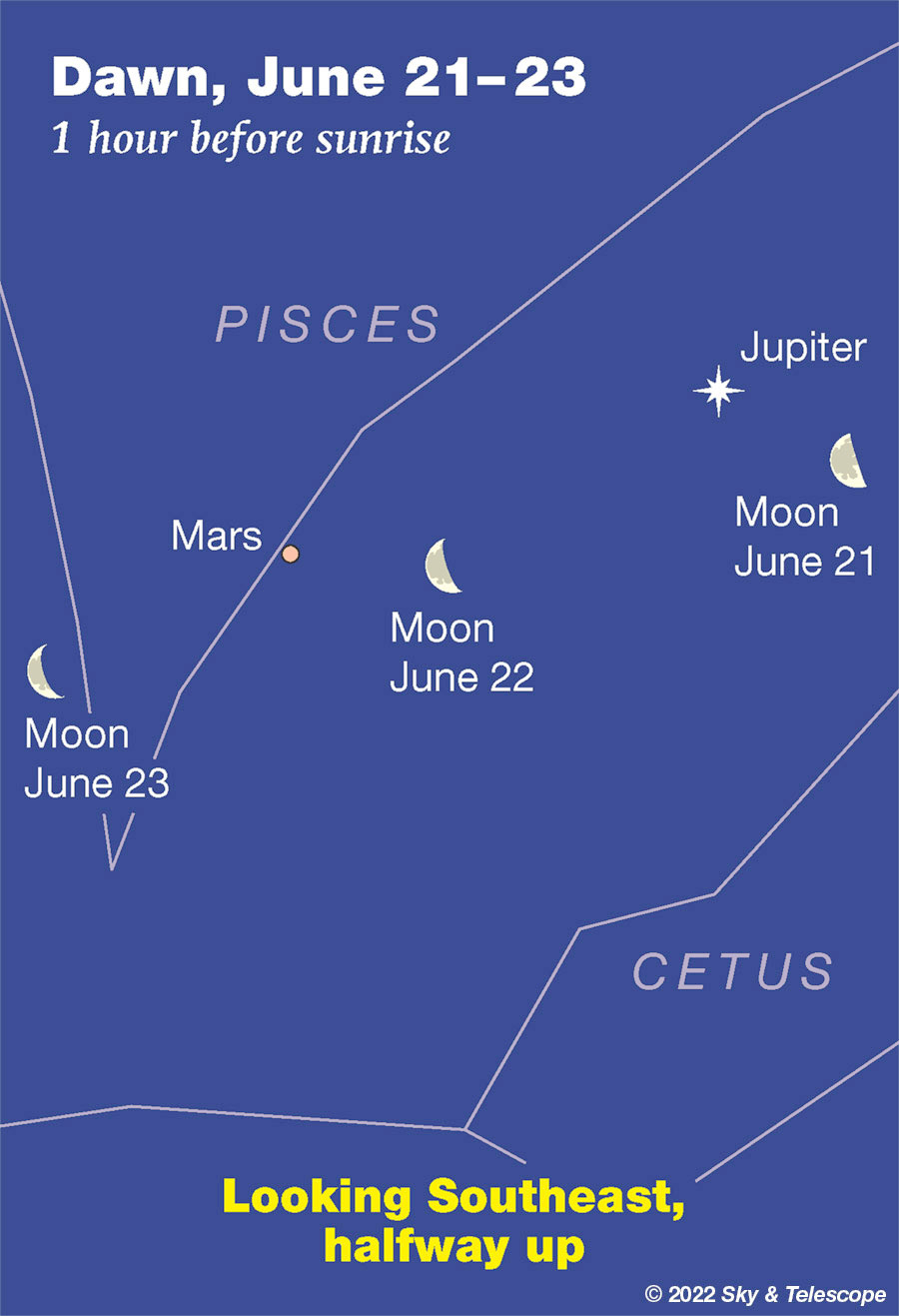
TUESDAY, JUNE 21
■ Happy summer! The solstice arrives this morning at 5:14 a.m. EDT. This is when the Sun is farthest north for the year (in Earth's sky) and begins its six-month return southward. Summer begins in the Northern Hemisphere, winter in the Southern Hemisphere.
For us northerners, this is the year's longest day.
It's also the day when (in the north temperate latitudes) the midday Sun passes the closest it ever can to being straight overhead, and thus when your shadow becomes the shortest it can ever be at your location. This happens at your local apparent [solar] noon, which is probably rather far removed from noon in your civil (clock) time.
And if you have a good west-northwest horizon, mark carefully where the Sun sets. In a few days you should be able to detect that the Sun is again starting to set just a little south (left) of that point.
■ Before or during early dawn on Wednesday morning the 22nd, look for Mars to the left of the Moon as shown above. Mars is still far away and just a tiny blob in a telescope, 7 arcseconds wide. But be patient. It'll grow to 17 arcseconds wide by its opposition early next December.
WEDNESDAY, JUNE 22
■ Look for the Big Dipper hanging straight down in the northwest after darkness is complete. Its bottom two stars, the Pointers, point toward modest Polaris to their lower right, by about three fists at arm's length.
Polaris is the end of the Little Dipper's handle. From there the rest of the Little Dipper now floats up. Perhaps it's a helium balloon escaped from some June evening party, trailing its string. Through light pollution, however, all you may see of the Little Dipper are Polaris at its bottom and Kochab, the lip of the Little Dipper's bowl, at the top. The rest of its stars are pretty dim at 3rd to 5th magnitude.
THURSDAY, JUNE 23
■ Leo the Lion is mostly a constellation of late winter and spring. But he's not gone yet. As twilight ends look due west, somewhat low, for Regulus, his brightest and now lowest star: the forefoot of the Lion stick figure.
The Sickle of Leo extends upper right from Regulus. The rest of the Lion's constellation figure runs for two or three three fist-widths to the upper left from there, to his tail star Denebola, the highest. He'll soon be treading offstage into the sunset.
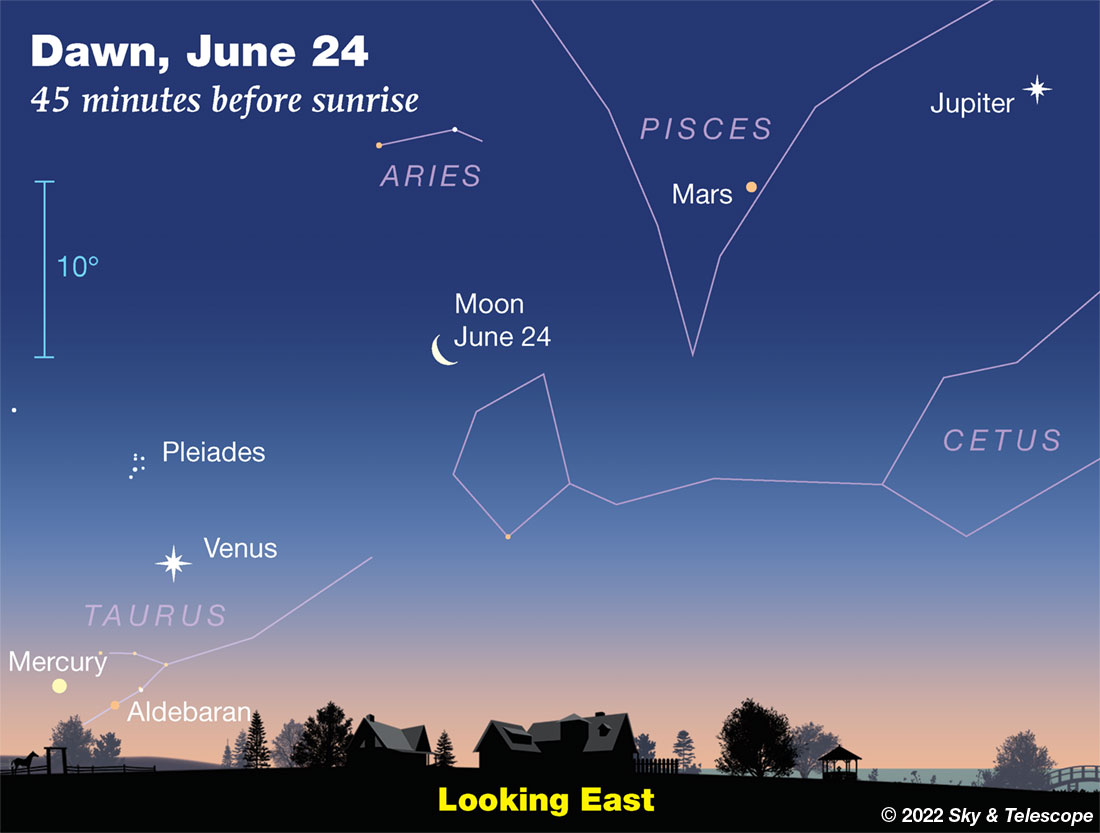
FRIDAY, JUNE 24
■ After dark, look southeast for orange Antares, "the Betelgeuse of summer." (Both are 1st-magnitude "red" supergiants). Around and upper right of Antares the other, whiter stars of upper Scorpius form their distinctive pattern. The rest of the Scorpion curls down toward the horizon.
Also right after dark, spot Arcturus way up high toward the southwest. Three fists below it is Spica. A fist and a half to Spica's lower right, four-star Corvus, the Crow of spring, is heading down and away.
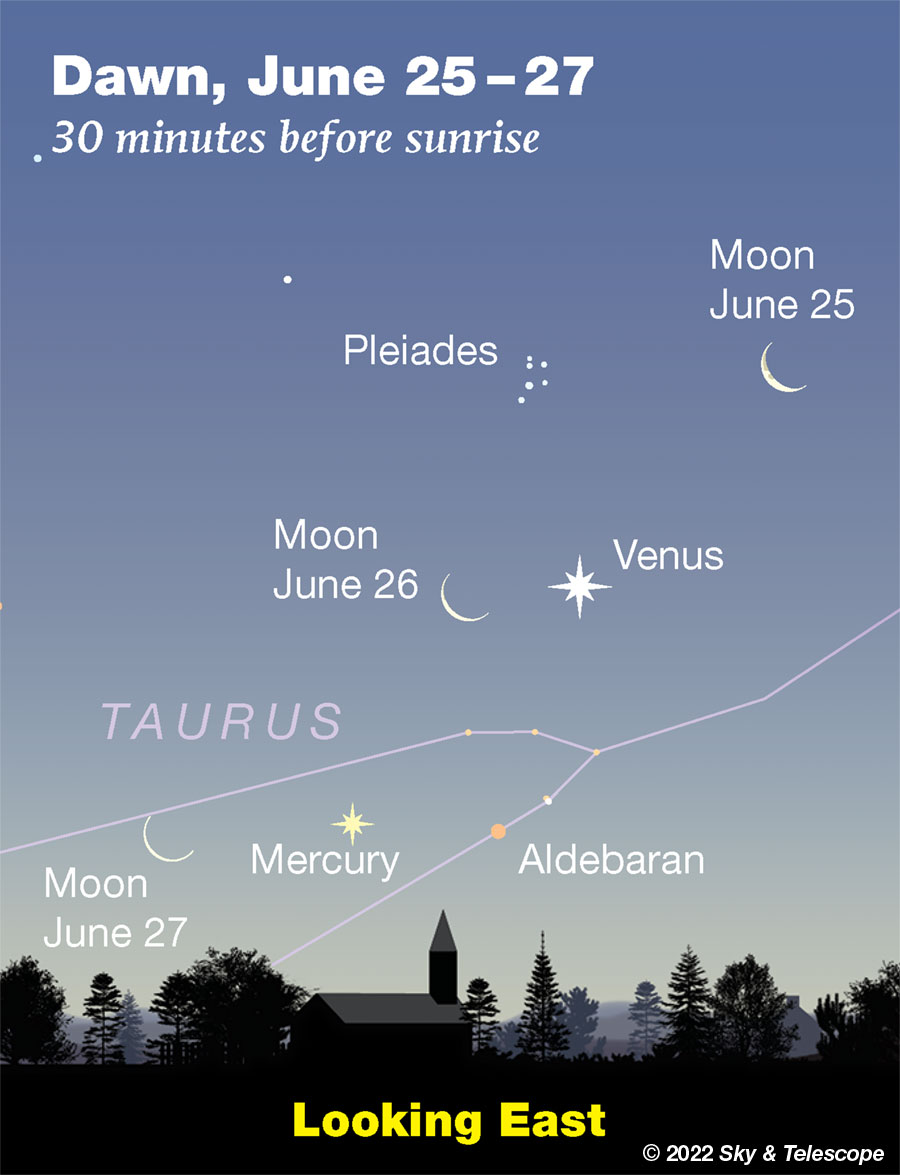
SATURDAY, JUNE 25
■ This is the time of year when the two brightest stars of summer, Arcturus and Vega, are about equally high overhead soon after dark: Arcturus toward the southwest, Vega toward the east.
Arcturus and Vega are 37 and 25 light-years away, respectively. They represent the two commonest types of naked-eye star: a yellow-orange K giant and a white A main-sequence star. They're 150 and 50 times brighter than the Sun, respectively — which, combined with their nearness, is why they dominate the evening sky.
This Week's Planet Roundup
Seven dawn planets! This week and next, with Mercury brightening, all five naked-eye planets form their best lineup in the dawn. Moreover, they're lined up in order of their distance from the Sun, counting from lower left to upper right.
Dim, sub-naked-eye Uranus and Neptune also lurk along the same line. And the Moon walks the length of the line this week, day by day as shown in the scenes above.
Mercury is low in the glow of sunrise, some 10° lower left of bright Venus all week as shown above. Mercury nearly doubles in brightness this week, from magnitude +0.4 on the morning of June 11th to a shinier –0.2 by the 18th.
Venus (magnitude –3.9) rises soon after the beginning of dawn. Look for it above the east-northeast horizon. It's very far lower left of bright Jupiter, by roughly five fists at arm's length.
Mars and Jupiter, very different at magnitudes +0.5 and –2.4 respectively, shine in the east-southeast before and during early dawn. Look for little Mars 12° to Jupiter's lower left on the morning of June 18th. Their gap widens to 16° by the 25th.
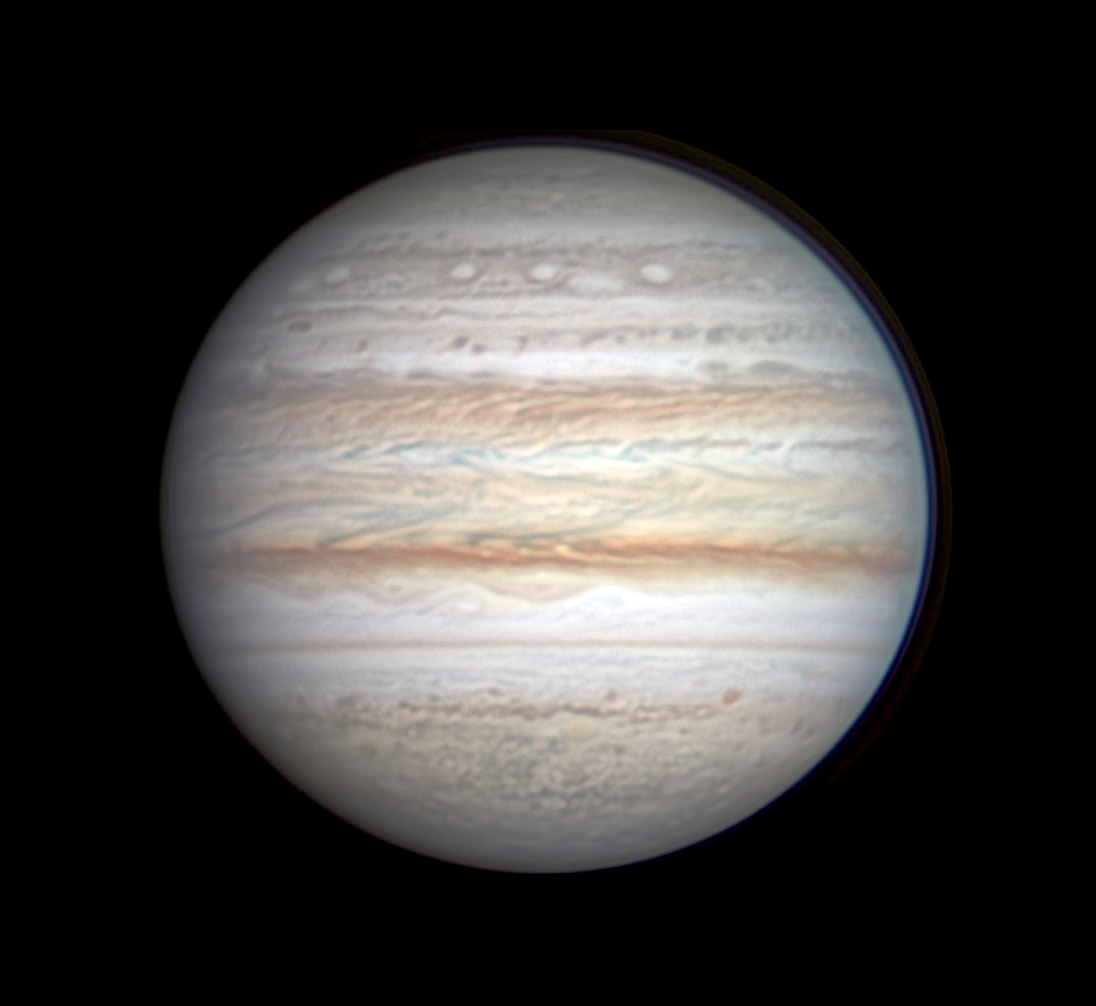
Saturn, magnitude +0.7, rises around 11 or midnight in eastern Capricornus. By the beginning of dawn you'll find it in the south-southeast, 40° (about four fists) to the right of Jupiter.
The little star 2° to Saturn's lower right is Delta Capricorni, magnitude 2.8. The reason Delta Cap has been staying there week after week is because Saturn is near its stationary point, the east end of the retrograde loop it performs against the sky every 12½ months. And, since Saturn is far away as planets go, its retrograde loop is small. So Delta Cap will keep fairly close company with Saturn all the way through August.
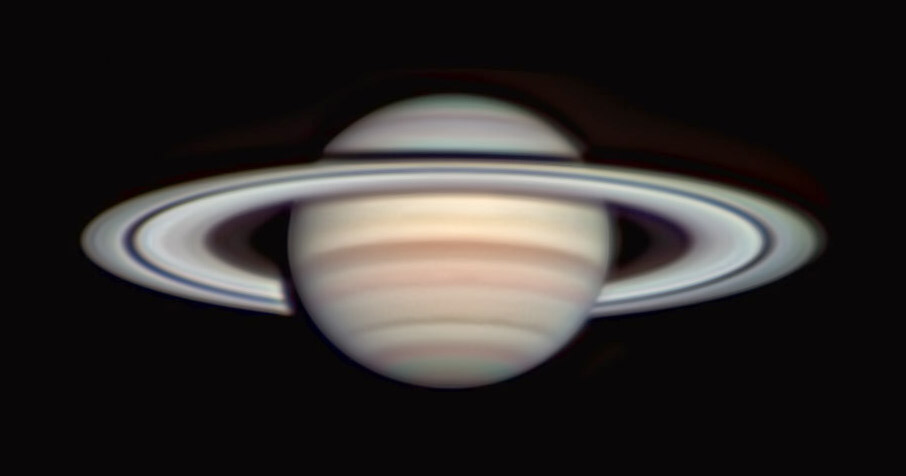
Uranus, magnitude 5.8, is washed out in the eastern dawn to the upper right of Venus.
Neptune, magnitude 7.9 at the Aquarius-Pisces border, is fairly well up in the southeast just before dawn begins.
All descriptions that relate to your horizon — including the words up, down, right, and left — are written for the world's mid-northern latitudes. Descriptions and graphics that also depend on longitude (mainly Moon positions) are for North America.
Eastern Daylight Time, EDT, is Universal Time minus 4 hours. (Universal Time is also called UT, UTC, GMT or Z time.)
Want to become a better astronomer? Learn your way around the constellations. They're the key to locating everything fainter and deeper to hunt with binoculars or a telescope.
This is an outdoor nature hobby. For an easy-to-use constellation guide covering the whole evening sky, use the big monthly map in the center of each issue of Sky & Telescope, the essential magazine of astronomy.
Once you get a telescope, to put it to good use you'll need a detailed, large-scale sky atlas (set of charts). The basic standard is the Pocket Sky Atlas (in either the original or Jumbo Edition), which shows stars to magnitude 7.6.

Next up is the larger and deeper Sky Atlas 2000.0, plotting stars to magnitude 8.5; nearly three times as many. The next up, once you know your way around, are the even larger Interstellarum atlas (stars to magnitude 9.5) or Uranometria 2000.0 (stars to magnitude 9.75). And be sure to read How to Use a Star Chart with a Telescope. It applies just as much to charts on your phone or tablet as to charts on paper.
You'll also want a good deep-sky guidebook. A beloved old classic is the three-volume Burnham's Celestial Handbook. An impressive more modern one is the big Night Sky Observer's Guide set (2+ volumes) by Kepple and Sanner.
Can a computerized telescope replace charts? Not for beginners, I don't think, and not on mounts and tripods that are less than top-quality mechanically, meaning heavy and expensive. And as Terence Dickinson and Alan Dyer say in their Backyard Astronomer's Guide, "A full appreciation of the universe cannot come without developing the skills to find things in the sky and understanding how the sky works. This knowledge comes only by spending time under the stars with star maps in hand."
![]() Audio sky tour. Out under the evening sky with your
Audio sky tour. Out under the evening sky with your
earbuds in place, listen to Kelly Beatty's monthly
podcast tour of the heavens above. It's free.
"The dangers of not thinking clearly are much greater now than ever before. It's not that there's something new in our way of thinking, it's that credulous and confused thinking can be much more lethal in ways it was never before."
— Carl Sagan, 1996
"Facts are stubborn things."
— John Adams, 1770
 9
9









Comments
misha17
June 17, 2022 at 1:24 pm
The "stats" for Mercury are for last week (June 11th-18th). Can you update them to June 18th - 25th?
You must be logged in to post a comment.
Anthony Barreiro
June 17, 2022 at 4:34 pm
The magnitudes are correct (according to SkySafari planetarium app), but the dates are wrong. Mercury will be magnitude +0.4 on June 18 and -0.2 on June 25.
You must be logged in to post a comment.
Anthony Barreiro
June 17, 2022 at 4:28 pm
On Wednesday morning June 15 I was able to see the Moon, Saturn, Vesta, Neptune, Jupiter, Mars, Uranus, Venus, and Mercury through 10x42 image stabilized binoculars. Bingo!
You must be logged in to post a comment.
Rod
June 18, 2022 at 11:31 pm
Very good Anthony on Bingo 🙂 I was out this evening using my 10-inch. [Observed 2000-2230 EDT. Sunset 2034 EDT, Moonrise 0036 EDT. Last Quarter Moon 21-June-2022 0311 UT. A target rich environment tonight. I used the X10i at 34x to 240x views. M13 globular cluster very lovely using TeleVue 9-mm Nagler at 133x view. I enjoyed the Double Double in Lyra at 240x. Epsilon 2a and b Lyrae I could split at 240x, Starry Night Pro Plus 8 shows they are 2.3 arcsecond angular separation. At 50 pc, ~ 115 au distance between the two stars. Epsilon 1a and b Lyrae were 0.93 arcsecond angular separation and at 240x, I could not resolve these two. M57 at 240x and 133x was a lovely ring shape and looked like a doughnut I could dip in coffee and eat 🙂 I viewed using TeleVue 35-mm PO for 34x low power, wide field views. M13 very bright after 2200 EDT and M92 very nice too, bright core and milky area spherical shape. Many targets tonight but I focused on M57, the Double Double in Lyra, M13, and M92 in Hercules. Bats were out earlier eating all they could and June fireflies all over the pastures and fields now. Temp 19C, winds NW 12 knots gusting 18 knots. Excellent viewing tonight.
You must be logged in to post a comment.
Rod
June 20, 2022 at 6:13 am
A lovely early morning sky today, clear and temps 11C. The nearly Last Quarter Moon in Aquarius and Jupiter in Pisces very bright at 0510 EDT. No BINGO for me but a great sight. I was tempted to setup my 90-mm refractor telescope and view the Moon and Jupiter, separated by about 16.5-degrees according to Stellarium. Coffee was calling and I went back inside, slowly waking up this morning 🙂
You must be logged in to post a comment.
Rod
June 21, 2022 at 4:47 am
Another lovely morning along the ecliptic today. Near 0430 EDT I could see Saturn in Capricornus, the Moon just past Last Quarter in Pisces, Jupiter in Pisces less than 5-degree angular separation from the Moon, Mars in Pisces. No Bingo but a lovely view with temps 14C and some cirrus above. Sunrise 0541 EDT this morning. Pisces is getting crowded now 🙂
You must be logged in to post a comment.
mary beth
June 21, 2022 at 12:19 pm
Let’s call that a “celestial school” !
You must be logged in to post a comment.
mary beth
June 22, 2022 at 12:03 pm
I always look forward to the mention of the little dipper looking like an escaped balloon from a summer party. It always falls right around my dear father-in-law‘s birthday. I love this column and the folklore! It sure makes stargazing even more fun!
You must be logged in to post a comment.
cyrtonyx
June 23, 2022 at 12:54 pm
No night viewing in New Mexico these last few nights. the North American Monsoon is in full swing. Overcast since June 16. At least the numerous fires are slowly going out.
You must be logged in to post a comment.
You must be logged in to post a comment.